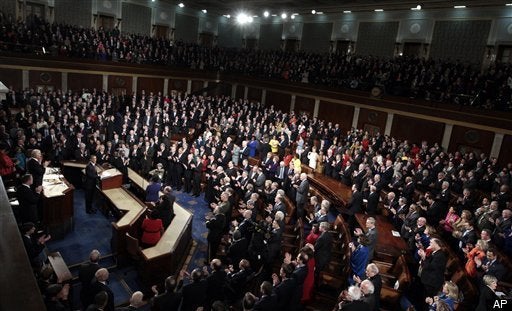
WASHINGTON - Polling bumps from State of the Union addresses are largely the stuff of myth. That's the message of before-and-after polls conducted over the last three decades. What might add a twist to this year's address, however, is an unusual context -- a new Republican House Speaker seated behind President Barack Obama and a recent bump in Obama's job approval ratings -- that could make for some unexpected impact.
Last year at about this time, Jeff Jones of the Gallup Organization authored a report describing the lack of impact of State of the Union addresses on public opinion. "Despite the amount of attention they receive," Smith wrote, "these speeches rarely affect a president's public standing in a meaningful way." He summarized data from 30 years worth of polling conducted just before and after the speeches and found the average change in approval was a decline of less than a full percentage point.
The one exception to this rule was Bill Clinton's address in 1998. As I wrote a few years ago:
The Monica Lewinsky story had broken just a few days before. The day before that speech, Bill Clinton faced the cameras and delivered his infamous "I never had sex with that woman" quote. MP cannot find the ratings for that speech, but interest in the speech was certainly high. Ironically, the reaction to Clinton's performance - seemingly unfazed by the scandal erupting around him - help[ed] boost his numbers in a way that persisted until the impeachment trial ended with an acquittal.
Thus, the one prominent exception to the "no bump" rule may have had less to do with perceptions of the speech itself and more about how the speech fit into the context of a larger event.
Jones' report also showed that the audiences for the State of the Union, as summarized in the table below, "tend to be heavily tilted toward the president's existing supporters."
The audience for President Obama's State of the Union address last year, as measured by a CNN/Opinion Research Corporation survey, identified as 38 percent Democrat, 25 percent Republican and 36 percent independent. So last year's audience was far more Democratic and less Republican than the audiences for speeches of President George W. Bush.
But that finding suggests the first way the context of this year's address might differ from the usual pattern. Notice that the least Democratic, most Republican audience of Bill Clinton's presidency was the 1995 speech, the one immediately following the Republican takeover of the House and Senate in 1994. The 1994 State of the Union was the first since 1954 to feature a Republican Speaker of the House (Newt Gingrich) seated immediately behind the president, and that change may have motivated an unusual number of Republicans to tune in.
Thus, an open question is whether the presence of Republican John Boehner in the Speaker's chair might produce a similar departure from the usual pattern in the partisanship of the television audience.
The recent uptick in the president's job-approval rating provides another potential difference in context. If Obama's gains result from the legislative successes of December's lame-duck session of Congress and Obama's handling of the shootings in Tucson earlier this month (rather than growing optimism about the economy ), then the State of the Union might have a perverse impact.
Consider the recent Obama polling bump in the context of a theory of public opinion advanced by political scientist John Zaller in his book, The Nature and Origins of Mass Opinion. Zaller argues that "flow of political communications" can be seen in terms of two models, a "two-message model" in which the pronouncements of political leaders divide along partisan lines leading to a polarization of public opinion and a "one-message model" in which they do not.
Applied to recent events, Zaller's theory would have us going from a two-message environment (in which Americans heard both praise and criticism of Obama) to a one-message environment (in which they hear praise from one side and mostly silence from the other in response to the lame-duck session and the Tucson shootings). Since this sort of one-sided information flow defies the usual gravity of our politics, Zaller's model suggests Obama's recent gains may be fleeting, like President Clinton's temporary polling bump after the Oklahoma City Bombings. (Thanks and a hat-tip to Brendan Nyhan for suggesting the Zaller model).
And that leads us to the possibility that the State of the Union address might have a slight negative impact on Obama's ratings: If the event marks a return to the usual polarized dialogue among political "elites," with Republican leaders resuming their intense partisan criticism, the president's approval ratings could fall. If, on the other hand, the optics of Republicans-sitting-with-Democrats or the substance of the address itself produces a less polarized reaction (or if Obama's recent gains are based more on growing optimism about the economy), Obama's bump may persist.
Either way, the unusual context of this year's address gives polling junkies something interesting to watch.
